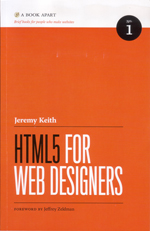 At last year’s Web Directions South conference, there was a session presented by Lachlan Hardy on The Open Web, a topic that until then had seemed to me impossibly esoteric and arcane. Could have been the name that threw me, I dunno.
At last year’s Web Directions South conference, there was a session presented by Lachlan Hardy on The Open Web, a topic that until then had seemed to me impossibly esoteric and arcane. Could have been the name that threw me, I dunno.
Anyway, Lachlan made perfect sense of it all by explaining it logically and with the passion of someone who doesn’t just understand something but really gets it, and from a perspective close to my own and in a voice that resonated strongly with me.
That’s what this book is like. HTML5 for Web Designers is pitch perfect.
In providing a practical overview of what HTML5 is and how it will affect what web designers do, Jeremy Keith has delivered something that is part conference presentation, part interview and part geeks moving coasters around a pub table.
Common to all of those is the active voice, and this book is very much Jeremy talking to you. He knows the background, he knows the politics and he most especially knows that you, jobbing web designer, just want to know whether it means you have to go back and recode everything you’ve ever done. And then learn Javascript.
What’s also common to those is that they are of a moment: not necessarily perishable, but likely to be superceded sooner or later by the next model. In the meantime, this will be the practical handbook for working with HTML5 for some time to come.
Anyone who’s seen Jeremy presenting at a conference knows he’s funny. It’s a witty, informed and clever funny. And still grounded in practical application. That’s what this book is like.
Look, frankly, I love that this book assumes I already know what I’m doing. It’s for people who are working web designers. If that’s you, you should get it.
HTML5 for Web Designers is badged as No. 1 in the new imprint A Book Apart: “brief books for people who make websites”, and represents an extension of web magazine A List Apart – itself a re-incarnation of a late ’90s web design mailing list which has more recently also moved into the US conference circuit with An Event Apart.
All but the newest or most cloistered web designers will recognise the names of the people behind all this: Zeldman, Meyer, Santa Maria. We’re talking quality, here – standards-compliant, CSS-driven, beautiful, functional quality. Yes, Virginia, web design now has stars.
In his foreword to HTML5 for Web Designers, Zeldman says that the goal of this book – and others to follow in this catalogue – is to “shed clear light on a tricky subject, and do it fast, so you can get back to work.”
That’s what this book is like.
Thanks, Ricky. That’s very kind of you.